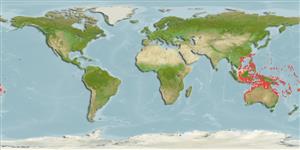>
Eupercaria/misc (Various families in series Eupercaria) >
Labridae (Wrasses) > Cheilininae
Etymology: Pteragogus: Greek, pteron = wing, fin + Greek, ago = to drive (Ref. 45335).
More on author: Bleeker.
Environment: milieu / climate zone / depth range / distribution range
Ekologi
laut berasosiasi dengan karang; kisaran kedalaman 2 - 64 m (Ref. 86942). Tropical; 26°N - 25°S, 108°E - 173°W
Western Pacific: Indonesia to the Coral Sea, north to Guam, south to southeastern Australia. Recently recorded from Tonga (Ref. 53797).
Size / Weight / umur
Maturity: Lm ? range ? - ? cm
Max length : 15.0 cm TL jantan/; (Ref. 9002)
Duri punggung (Keseluruhan (total)): 9; duri punggung lunak (Keseluruhan (total)): 11; Duri dubur 3; Sirip dubur lunak: 9. It can be distinguished from the other species by its longitudinal lines along the body (Ref. 48636). Differs from P. cryptus and P. guttatus by having IX, 11 rather than X, 9-10 dorsal rays and males with filamentous extensions on first two rather than the first four interspinous dorsal membranes (Ref. 37816).
Found in various habitats from shallow algae reefs to deep offshore on soft bottom with sponges and hydroid colonies (Ref. 9002). Mostly small, secretive species, usually hiding among dense weeds (Ref. 9002). It rarely leaves its cover except to move quickly between hydrozoan colonies, but not before having a good look around first to make sure its safe (Ref. 48636).
Life cycle and mating behavior
Kematangan | Reproduksi, perkembang biakan | Pemijahan | telur-telur | Fecundity | Larva
Oviparous, distinct pairing during breeding (Ref. 205).
Kuiter, R.H., 1993. Coastal fishes of south-eastern Australia. University of Hawaii Press. Honolulu, Hawaii. 437 p. (Ref. 9002)
Status IUCN Red List (Ref. 130435)
ancaman kepada manusia
Harmless
penggunaan manusia
informasi lanjut
AcuanBudidaya airprofil budidaya airStrainGenetikaElectrophoresesDiturunkanPenyakit-penyakitPengolahanNutrientsMass conversion
mitraGambarStamps, Coins Misc.Suara-suaraCiguateraKecepatanTipe renangArea insangOtolithsOtakPenglihatan / visi
Alat, peralatan
laporan khas
muat turun XML
Sumber internet
Estimates based on models
Preferred temperature (Ref.
123201): 25.2 - 29.3, mean 28.4 °C (based on 1669 cells).
Phylogenetic diversity index (Ref.
82804): PD
50 = 0.5010 [Uniqueness, from 0.5 = low to 2.0 = high].
Bayesian length-weight: a=0.01585 (0.00707 - 0.03555), b=2.95 (2.76 - 3.14), in cm total length, based on LWR estimates for this (Sub)family-body shape (Ref.
93245).
Trophic level (Ref.
69278): 3.5 ±0.4 se; based on size and trophs of closest relatives
Daya lenting (Ref.
120179): Tinggi, Waktu penggandaan populasi minimum kurang dari 15 bulan (Preliminary K or Fecundity.).
Fishing Vulnerability (Ref.
59153): Low vulnerability (10 of 100).
Nutrients (Ref.
124155): Calcium = 82.1 [49.7, 139.3] mg/100g; Iron = 0.716 [0.423, 1.308] mg/100g; Protein = 18.4 [15.6, 20.6] %; Omega3 = 0.171 [0.110, 0.266] g/100g; Selenium = 27.4 [16.4, 48.2] μg/100g; VitaminA = 143 [44, 532] μg/100g; Zinc = 1.66 [1.14, 2.57] mg/100g (wet weight);
